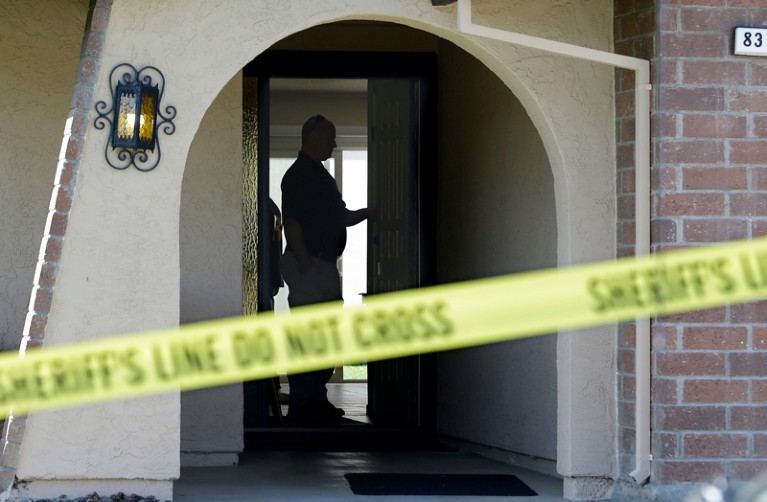
The use of ancestral DNA data to track a suspected murderer raises some troubling ethical questions.Credit: Rich Pedroncelli/AP/REX/Shutterstock
Last week’s arrest of a suspect in the Golden State Killer case in California has highlighted how DNA samples that have been volunteered for one purpose — in this case, genealogy — can be used for other reasons, often without the donor’s explicit consent. Several ethicists have expressed concern about US detectives using a genealogy website in this way. Coming so soon after the reuse of Facebook data in political campaigns in the Cambridge Analytica scandal, it’s another example of how new technology and techniques lead to unexpected conundrums, and how ethical and societal debate must catch up.
The case of the Golden State Killer, linked to at least 50 rapes and 12 murders between 1976 and 1986, had gone cold — although investigators believed they had a reliable sequence of the perpetrator’s DNA. Next they needed a match. So, according to reports, they uploaded the data to a popular website that compares people’s genetic information to trace their relatives — in effect, creating a profile for him. They got lucky: a match with family members led them to identify and arrest Joseph James DeAngelo.
Just like the Cambridge Analytica case, this one raises the question of how much control people have over information they give to public or commercial databases. DeAngelo’s relatives submitted their DNA for the specific purpose of genealogy, which by definition requires the information to be shared and compared. Then they saw it used for something else without their consent. In discussions of the case, users of genealogy services are divided between those who say the police were justified, given the seriousness of the crimes, and those who were shocked by the move.
Such users have received other surprises. Thousands of people have discovered through genetic analyses that their parents were not who they thought they were. Others have found and been reunited with siblings they never knew existed. Such discoveries have implications for users’ wider family members, most of whom won’t have put their DNA in such a database.
In the California case, the involvement of the police adds an extra dimension. People who choose to upload their DNA could unknowingly be helping police to trace a relative — now and in the future.
Investigators have long coveted the genetic information held in others’ databases. After the Swedish politician Anna Lindh was assassinated in 2003, Swedish police asked for access to a suspect’s DNA stored in a biobank, so that they could compare it with DNA found at the crime scene. Their access was granted. But other requests have been turned down by courts. In 2006, the Norwegian Supreme Court said that police investigating a suspected armed robber, who had died six months after the crime, could not access his genetic information held by a hospital. The dead can’t be libelled, but they can have their privacy invaded. And scientists in Belgium wrestled with these issues in 2016, when they confirmed the location of the 1934 death of King Albert I from blood samples collected there. They decided not to publish sequence details because of possible implications (including paternity and health) for his surviving descendants, including members of the current Belgian and British royal families.
To what extent can scientists and companies who collect such information anticipate future uses and make them clear to participants and customers? There are no easy answers, because many of those uses cannot be anticipated at the time. Still, a 2016 survey showed that online firms that collate and compare DNA for consumers are too vague about how it might be used (E. Niemiec and H. C. Howard Appl. Transl. Genom. 8, 23–30; 2016). On the basis of what they do know, many organizations should take steps to inform people better. (In the California case, users of the site, GEDmatch, were told that “other uses” were possible and that they should remove their data if this was unacceptable.)
If police can use genetic databases to catch killers — even those who are distant relatives of individuals who have submitted their DNA — then perhaps more people will sign up to share their DNA. But they should be told that this is a possibility, and be given the choice to opt out. Meanwhile, more geneticists, ethicists and lawyers need to debate other potential ways in which genetic information is likely to be used, so that ethics leads the conversation, rather than playing catch-up.

 The scant science behind Cambridge Analytica’s controversial marketing techniques
The scant science behind Cambridge Analytica’s controversial marketing techniques
 Cambridge Analytica controversy must spur researchers to update data ethics
Cambridge Analytica controversy must spur researchers to update data ethics


